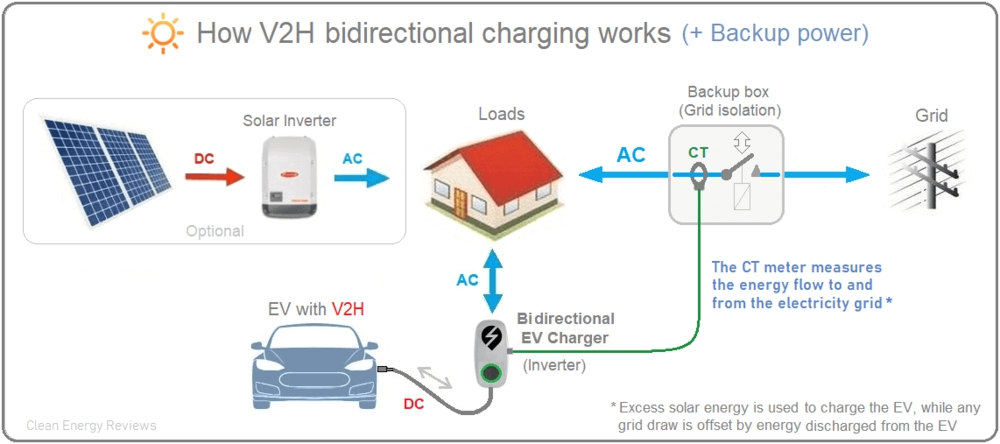Vehicle-to-grid is where a portion of the EV battery energy is discharged and exported to the electricity grid when the demand is high in exchange for an incentive or reduced electricity costs, depending on the service contract. To participate in V2G programs, you will require a bidirectional DC charger and a compatible EV. Of course, there are some financial incentives to do this and EV owners are given credits or reduced electricity costs to participate. EVs with V2G can also enable the owner to participate in virtual power plants (VPP) programs to improve grid stability. Only a handful of EVs currently have V2G and bidirectional DC charging capability; these include the later model Nissan Leaf (ZE1) and the Mitsubishi Outlander and Eclipse plug-in hybrids.
Part of the problem with the role out of V2G technology is the regulatory challenges and lack of standard bidirectional EV charging protocols and connector type. Some vehicle manufacturers, such as Ford, have developed bidirectional chargers that only operate with Ford EVs. Others, such as Nissan, operate using universal bidirectional chargers such as the Wallbox Quasar, described in more detail below.

Vehicle to Grid (V2G) technology using a capatible DC bidirectional charger
Nowadays, most EVs are equipped with the standard CCS DC charge port. Currently, the only EV that uses a CCS port for bidirectional charging is the soon to be released Ford F-150 Lightning EV. However, more EVs with CCS connection ports will be available with V2H and V2G capability in the near future, with VW announcing its ID electric cars will offer bidirectional charging later in 2022.
Vehicle-to-home or V2H is similar to the V2G, but the energy is used locally to power a home instead of being fed into the electricity grid. This enables the EV to function much like a regular household battery system to help increase self-sufficiency, especially when combined with rooftop solar. Another benefit of V2H is the ability to provide backup power in the event of a blackout.
In order for V2H to operate, it requires a compatible bidirectional charger and additional equipment including an energy meter (CT meter) which must be installed at the main grid connection point. The CT meter monitors energy flow to and from the grid. When the system detects energy being consumed by your home from the grid, it signals the bidirectional EV charger to discharge at an equal amount, thus offsetting any power drawn from the grid. Likewise, when the system detects energy being exported from a rooftop solar array, it diverts this to charge the EV, which is very similar to the way smart EV chargers work.

Basic energy flow diagram of a DC bidirectional charger using V2H to power a home, plus CT meter to measure grid energy flow.
Only a few EVs currently feature V2H technology, including the later model Nissan Leaf and Mitsubishi Outlander PHEV, which both use the older-style CHAdeMO connector. The new Ford F-150 Lightning EV is unique in that it is the first vehicle with bidirectional charging capability to use a CCS connector. However, it can only function when used with the Ford Charge Station Pro along with the Ford Home Integration System. The F-150 Lightning also features Vehicle-to-load (V2L) technology, as described below.
Vehicle-to-load or V2L technology is much simpler as it does not require a bidirectional charger to operate. Vehicles with V2L have a built-in DC to AC inverter and standard plug-in AC power outlets which can be used to plug in any regular household AC appliances. In an emergency, extension cords can be run from the vehicle into a home to power essential loads, including lighting, computers, fridges, and even cooking appliances.
The new Ford F-150 Lightning has V2L capability via four 2.4kW AC power outlets for a total of 9.6kW of power. Other vehicles which feature V2L technology include the new Hyundai IONIQ 5 and Kia EV6, which have both internal and external AC power outlets, and the BYD electric vehicle range including Yuan Plus (Atto 3).

Basic energy flow diagram of an EV with an AC power outlet which is known as vehicle-to-load or V2L.